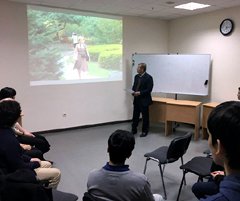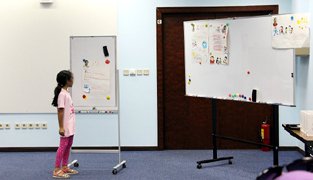The State of Japanese-Language Education in Uzbekistan Part 2
The Uzbekistan-Japan Center
YAMASAKI Noriko
The people of Uzbekistan have exceptional language ability.
This is something that I have believed since the very beginning of my dispatch here. In Tashkent, the capital of Uzbekistan, many people are bilingual and speak both Uzbek and Russian, and when I listen to their conversations, I notice something fascinating: they often switch between the languages as they speak. It actually seems quite natural as they switch from Uzbek to Russian and back again during the course of their conversation, so they apparently do not decide ahead of time which language to speak.
In 1995, four years after gaining independence from the Soviet Union, Russian disappeared from the list of official languages, leaving only Uzbek. While I am told that the number of young people who cannot speak Russian are rising, the use of Russian is still allowed in official documents, so the language continues to maintain a high status. The ability to speak Russian is also often an advantage in academia and business, so those who wish to be successful in the latter endeavor are said to need to speak not only Uzbek and Russian, but also English and at least one other language. Therefore, studying a foreign language is not a rare thing in Uzbekistan. Rather, it is a given.
At the Uzbekistan-Japan Center (hereinafter “UJC”) where I am dispatched, about 270 learners study Japanese throughout the year. While about half of the students are in their teens now, the number of working adults is also steadily rising. Numerous Japanese-language schools have been opened in Uzbekistan in just the past several years, while Japanese classes were also begun as an official subject at some primary and secondary educational institutions in Tashkent, so Japanese-language learners are now diversifying to include everyone from primary school students to adults. Given this situation, the aim of the UJC is to provide a unique educational opportunity unavailable at other educational institutions. Below, I will introduce some of our initiatives.
UJC Japanese-Language Course Festival
The UJC carries out our largest event of the year, the UJC Japanese-Language Course Festival, every June. The event last year was a great success with over 200 participants, including students and their families and friends. The festival program included song and dance by students, screenings of videos made during class, and games about Japan and the Japanese language. The festival is planned and run by the staff of the UJC Japanese-Language Course, but the students also prepare beforehand, such as by practicing their songs and other performances. The students all look forward to the festival, so as the organizers, we put great effort into planning and preparing to meet those expectations.
Japanese Cultural Experience and Visitor Session
The “Marugoto: Japanese Language and Culture” (hereinafter “Marugoto”) course that we run includes a Japanese cultural experience and visitor session every three months. The cultural experience consists of preparing Onigiri rice balls, making Japanese sweets, Shodo calligraphy, Origami paper craft, and playing with traditional Japanese toys. The Japanese sweets and Shodo portion of the events are realized through the cooperation of the tea ceremony and Shodo teachers at the UJC. The students were trying Origami for the very first time, so I found it somewhat entertaining to watch them struggling to create a crane, which was a bit difficult for them to do. The students enjoy every part of these sessions because of their universal interest in Japanese culture.
Meanwhile, the visitor sessions involve local Japanese residents visiting the class to interact with the students and hear presentations from them. The students are always worried whether their Japanese will be understood, so the presentations and interactions with Japanese people serve to raise their confidence by slowly building what they are capable of doing.

A presentation of a Marugoto course
Marugoto Short Courses for Children
The Marugoto course at the UJC targets students aged 14 and over. Though the “Marugoto: Japanese Language and Culture” teaching materials are geared towards adults from the general public, I have worked with the full-time lecturers at the UJC to arrange them into a short course for children aged 10 through 14. I then held two four-week courses (8 sessions of 90 minutes) for Module 1 last summer.

A presentation at the end of the Marugoto short course for children.
To be frank, it was very hard to prepare for the course. First, we would decide on a topic and then have a meeting to discuss the content to present for it. When that would finish, we would start creating slides, and hold meetings to decide on and fix the details, such as what to do about conversation and what other activities to include. Then one week before the start, we involved JICA volunteers for voice recording. Accordingly, it took us over a half year simply to prepare for just those eight sessions. In the end, five of the eight sessions were on topics such as family, hobbies, and favorite foods, followed by two more sessions involving making sushi rolls with parental involvement, and preparing and practicing for the final presentation of topics, which took place on the final session. Parents were also invited to the presentation and were able to see the results of the four weeks of study.
Module 2 is scheduled to be held this summer. I am currently working with the instructors in charge in the hopes that the short course will become a summer tradition at UJC.
- What We Do Top
- Arts and Cultural Exchange [Culture]
- Japanese-Language Education Overseas [Language]
- Japanese-Language Education Overseas [Language] Top
- Learn Japanese-language
- Teach Japanese-language
- Take Japanese-Language Test
- Know about Japanese-language education abroad
- The Japanese-Language Institute, Urawa
- The Japanese-Language Institute, Kansai
- Japanese-Language Programs for Foreign Specified Skilled Worker Candidates
- Japanese Language Education for Japanese Children Resident Overseas and for the Descendants of Migrants
- Archives
- Japanese Studies and Global Partnerships [Dialogue]
- JF digital collection
- Other Programs / Programs to Commemorate Exchange Year
- Awards and Prizes
- Publications
